Review of Xiaomi Mi TDS Water Quality Tester Pen
With the use of modern technology, there are gadgets that you can now use that help you have a more healthy environment. I’ve talked before about air quality monitors. Today I want to tell you about water quality testers. After all, about 60% of our body is made up of water, and so it is important that you are drinking good quality water. Back home in the UK, we are used to just drinking water from the tap. However, here in Thailand, our lives revolve around drinking filtered water or bottled water. We would never drink straight from the tap even though the Metropolitan Waterworks Authority assures us it is safe to drink. For general purposes, I use a water filter in my house. But, how to know when it is time to change the filter? As I neglected to note down the last time that I changed my filter, I decided to buy a Xiaomi TDS Water Quality Tester Pen to see if the purity remained good. This is the review of that tester pen and my experience of using it in my daily life.
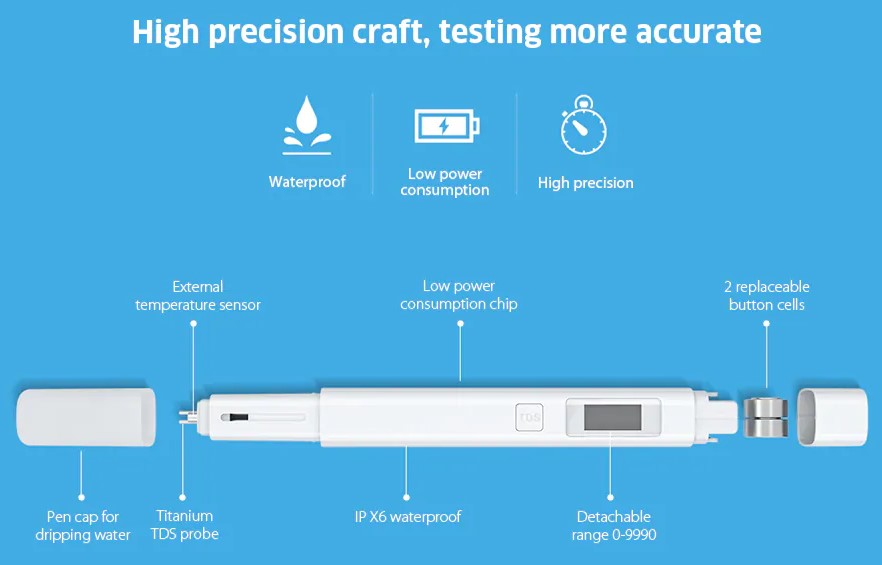
Xiaomi is a well-known electronics company based in China. They make smartphones, laptops and other electronic devices like the MI Air Purifier 2 which I reviewed earlier. The Mi TDS Pen Tester is another of their products. As the name suggests, it looks a bit like a ballpoint pen though it is slightly bulkier. There is a cap at one end which protects the electrode sensors. The cap is also where you put the water that you are testing. The other end is for two replaceable button batteries. There is a small LCD screen which unfortunately isn’t backlit. So, not always that easy to read. To turn on the meter, just press the button. The reading should be zero. It will turn itself off after a few minutes or you can just press the button again.
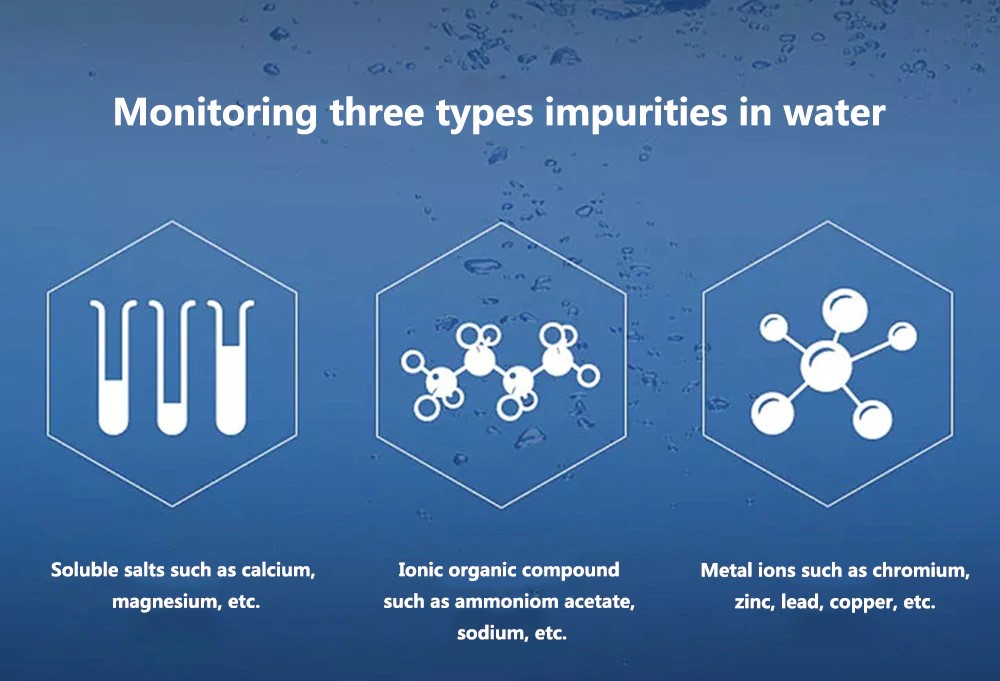
TDS stands for ‘total dissolved solids’ which includes Soluble salts such as calcium, magnesium, etc, Ionic organic compound such as ammonium acetate, sodium, etc., and Metal ions such as chromium, zinc, lead, copper, etc. TDS is measured in PPM which stands for ‘parts per million’ or just mg/L which stands for ‘milligrams per liter’. Basically, the lower the reading, the higher the purity of your water. WHO says that any water with a reading of less than 300ppm is regarded as good to drink. Though you can drink any water up to about 1,000ppm. In theory, that is. It may contain harmful chemicals. More about that in a moment.
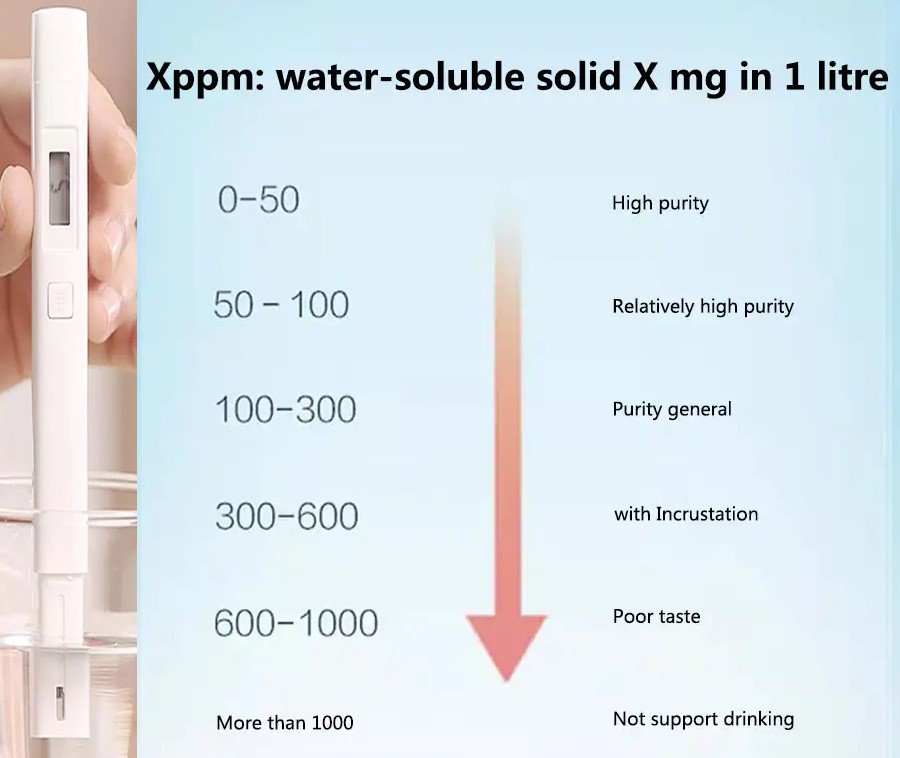
Lowering TDS is done through reverse osmosis (RO). A good RO filtering unit can reduce dissolved solids by more than 90%. Bottled water sold in Thailand and some home water purifiers may use RO together with ultraviolet treatment and/or ozone treatment. UV Water Purification systems remove 99.99% of bacteria and viruses. Ozone purifiers can remove 99% of all biological pathogens including Giardia and Cryptosporidium. The TDS meter pen can check for the purity of your water, but it cannot check for things such as bacteria, viruses and other harmful substances. For that, you will need a laboratory. All I wanted to do with the TDS meter pen was to see how well my water purifier was working. Was it reducing dissolved solids by at least 90%? First I tested my tap water which had a reading of 161ppm which is pretty good compared to some countries. I then tested my purified water and that was only 6ppm. So, I can presume that it is still doing a good job.

The Xiaomi Mi TDS Pen is easy to use. The meter pen comes with batteries already installed so that you can use it straight out of the box. All you have to do is put some water you want to test into a cup or the pen cap. Then press the button on the pen to turn it on making sure it says zero. Then put it into the water. You only have to wait a few seconds. Unfortunately, there is no hold button and so as soon as you take it out of the water, it quickly goes back to zero. So, putting the water into the cap is more efficient. In the photo above, the Mi TDS Pen is pictured together with the more bulkier TDS EZ which I bought a few years ago on Amazon. They are much alike, though the TDS EZ has a hold button which makes it easier to see the results. Their test readings were very similiar. Particularly for purer water. However, the large the number, say for example 200+ ppm, then the bigger the difference between them. But only by about 5ppm.
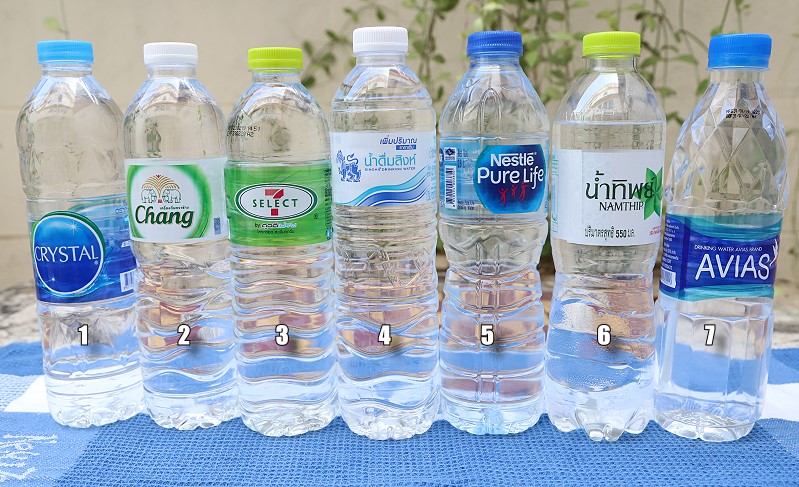
Once I had tested my tap water and filtered water, I naturally wanted to then check bottled water. Which brand has the purest water? But, before I give you the results, I need to give a warning. Natural spring water or mineral water will give a high TDS reading of say around 300ppm. Other bottled water may have some minerals added. Not just for health, but for taste too. Although my purified water having a reading of only 6ppm is very good, it is also tasteless and doesn’t contain any minerals that your body may need. But, I don’t care so much, I can easily get minerals from eating a balanced diet. So, here is the result of these popular brands of bottled water sold in Thailand. You might be surprised by some of the results: (1) Crystal 20ppm, (2) Chang 122ppm, (3) 7 Select 5ppm, (4) Singha 344ppm, (5) Nestle Pure Life 220ppm, (6) Namthip 25ppm, and (7) Avias 36ppm.
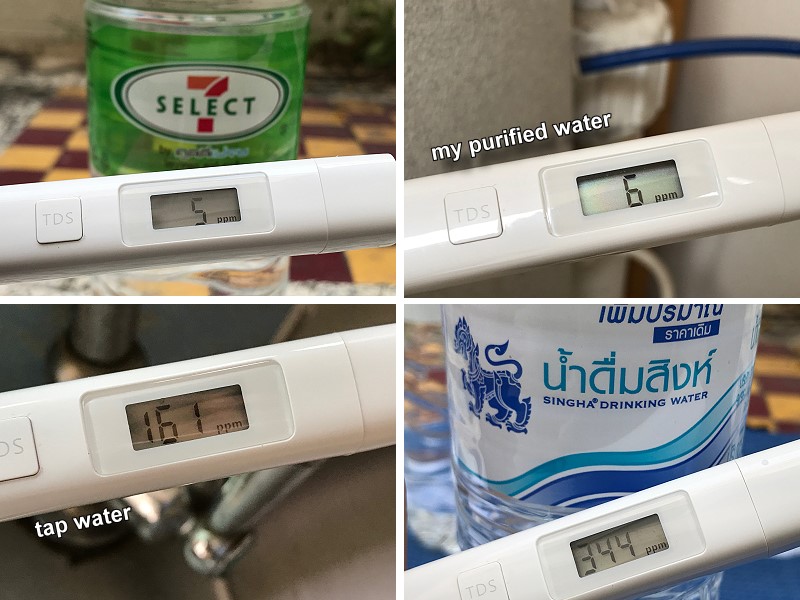
I need to emphasize again, that a higher TDS reading doesn’t mean unsafe water. It just means the water isn’t pure and has been fortified with something. As you can see from the readings I took, 7 Select, which is one of the cheapest brands available, had a reading of only 5ppm. At the other end of the scale was Singha Drinking Water with a reading of 344ppm. Which was very surprising. I actually went to a different shop to buy another bottle just to make sure. I also tested with the other TDS pen I had. The results were still high. I am not saying the water isnt clean. I am just saying it is not pure. Something has been added, but I cannot tell what as there is nothing mentioned on the label. It only says NSF certification (National Sanitation Foundation) which is an international standard of quality. Chang water and Nestle Pure Life also has this certification. The question is whether we trust them or not or just go for the purest water available. After all, as I said before, we can get our minerals from eating a balanced diet.
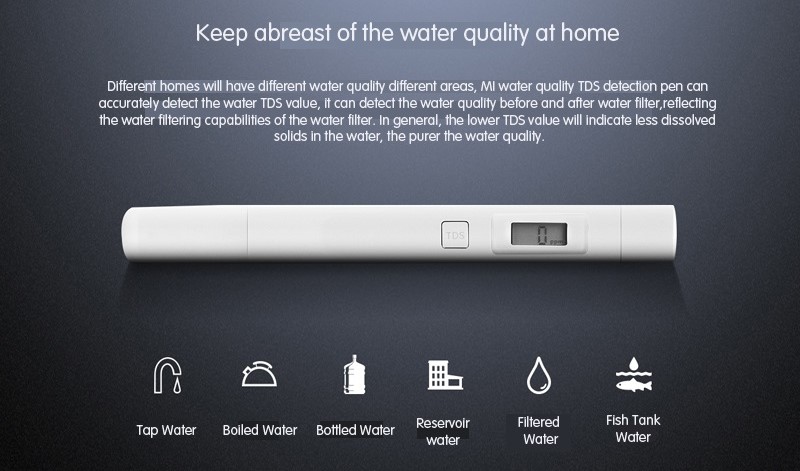
I bought the Xiaomi Mi TDS Pen on Lazada for just over 200 Baht. Here is a link to for all TDS pens on Lazada. Of course, other shopping venues are available. In every case, be careful that you are not buying a counterfeit item. I like the brand Xiaomi and I think many of their products are stylish. Their TDS pen seems reliable and is small and light enough to carry around on my travels. The price is not expensive too. If you have a water filtration system at home, I would strongly suggest that you buy a TDS pen to check on the purity of your water. You will find it invaluable. After I mentioned to a Thai friend of mine that I had bought a TDS meter pen, she asked me to test the filtered water in her house. Which I did and the results were a high 165ppm. This is basically the same as her tap water and showed me that her filtration system wasn’t working at all. So, basically, she had been drinking tap water thinking it had been purified by filters. She has now ordered some replacement filters.
As before, if you have had experience with this TDS pen or any others, please post your thoughts in the comments below. I’m also interested to have your opinion about the bottled water that I tested. Why did some test so high? Are they spring water or mineral water? There are also other affordable water quality testers on the market that test things like pH and EC. Do you have any experience with these? Thanks for reading and I hope I have helped some people.

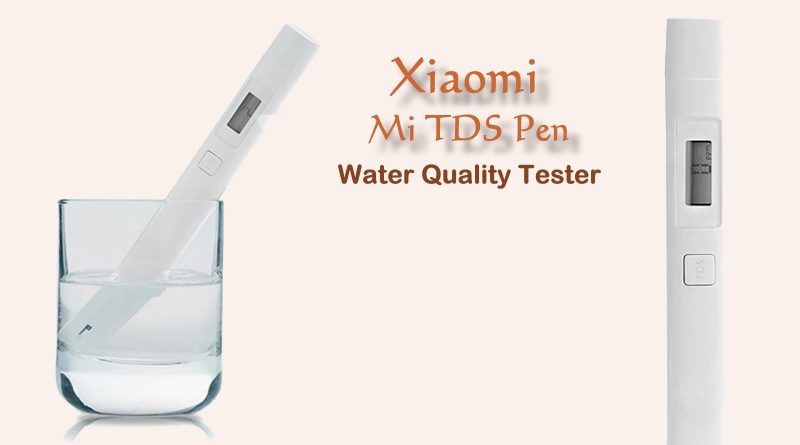

Hello is TDS xiomi pen is disposable or the battery need to replace coz sometimes not working.and what type of battery.
If you didnt find it yet, yes you can.
Lazada is always a good place to start looking: https://www.lazada.co.th/catalog/?q=+Xiaomi+MI+TDS+pen&_keyori=ss&from=input&spm=a2o4m.home.search.go.6aab6f84LNfHNu
You can also buy other brands at your local water filter company or even Amon over by their under sink RO kits. I buy a few a year on Lazada. We test a few times a day with three different brands of TDS meter to watch trends in our little Issan bottled water factory. Keep one in each vehicle for use at restaurants too 😉
Where can I buy a piece of Xiaomi MI TDS pen.
This is all a puzzle. I bought a Brita 8.5l tank filter and plan to use it to turn our Condo filtered bore (not city) water into drinking water.
The tap water measures 207ppm in and 147ppm out of brita, using the xiaomi pen.
So far so good.
But then Singha bottled water measures 293ppm in, and 217ppm out!! I understand this is due to added minerals in the Singha (though I dont know what), but of course I am unsure if the Brita filtered condo water is ‘pure’ enough to drink.
It seems that I really need to get the brita filtered tap water lab checked and then just use the xiaomi pen to check when the brita filter needs changing.
Any enlightening thoughts welcome.
Hello
I live in Hungary, and we drinking natural spring water from a mountain top spring . It tastes good, and once in a year there is an offical measuring.
Can I use this Xiaomi tool to watch the water quality? Is it suitable for this purpose? I think in my case the biologcal (germs, bacteria, etc) is the most important…
Thanks for any advice
Istvan
No, Tds meters only measure “dissolvable solids”. Not bacteria, not viruses or even if the water contains dangerous chemicals or not. The only value you can get by using it is to tell if your water filter works, by measuring the water before and after.
I tested my water from my amway filter machine “e-spring” it shows the same TDS reading as my tap water, and this filter machine suppose to add valuable minerals to the water (as marketed by salesperson). So high mineral water can show higher readings but how do I know if its purified and clean to drink? Putting aside its beneficial mineral properties. How do I check its impurities?
Thanks, Carina
Richard, how about testing “Sprinkle” and the other big bottle dispenser companies?
Thanks for the reply. Thought about water delivery too will look into it again. Purifier system seemed like a good solution where we probably only have to replace the filter every 6 months or so .
Hi thanks for this informative blog post.
I am curious to know which water purifier system you are using?
Thinking about installing a system in BKK condo and wondering about quality and cost effectiveness.
Greetings Dennis
Great article Richard, appreciate the positive and helpful content.
Excellent review Richard. I’m glad you explained how the values in the TDS meter should be taken as just part of the picture. Other “testing” people can do themselves is the TCS test (taste, color and smell. These are important especially for refill 18.9 or 20 liter jugs.
RE the RO: To put some of this in perspective, we change our 10500 gpd RO membrane once the TDS is around 35. This membrane can work very well about a year if it is flushed with RO water every hour for 2 min and at startup /shut down. Other ways the reputable water treatment companies (like ours) treat the water and reduce contaminants before the RO is chlorine treatment in holding tanks right after the well, anthracite/manganese filtration, carbon filtration and resin prior to the ceramic filter. UV light treatment is also important particularly just before filling.
Coliform bacteria testing is another important part if you are using tap water or well water or even refilled bottle water for that matter as you are relying on the water company to do a good job cleaning and disinfecting. There are many other tests to be done including but not limited to pH but reliable meters for these tests and pH get kind of expensive for the average consumer.
The Water Quality Association is a good general resource: (www.wqa.com). I have some other information on our website (www.jdbeverage.com) for those interested.
Keep up the great work Richard! Been a fan since 2010. You provide critical info in times of unrest and interesting info the rest of the time! -JD
Great, thanks. Very informative.
Singha water is the byproduct of their brewing process.
Interesting ! Thanks !
Here is a previous case where someone ‘misinterpreted’ high tds to mean undrinkable and got sued: https://www.khaosod.co.th/special-stories/news_426095
Yes, which is why I was very careful in my tweets and blog review to say high TDS doesn’t mean it’s undrinkable. It could be mineral water or fortified with something.
First of all: sorry for my “not so good English” but: this pen is measuring the impurities in water but you don’t know WHAT those impurities are. In fact, the measurement says nothing at all about the drinkability of the water. If the measurement is only 001 ppm but the “1” is cyanide, you will die. So it’s obvious that you can not assume that the water is safe to use even with only 1 ppm. As you said before, you will need a lab to test this. However, there is some military portable equipment (not cheap) that can tell you if the water is “safe to drink”. Just my 2 cents.
Sure, I understand that. But it’s better than not testing at all. I just want to know if the tap water has been purified when it goes through the RO and UV process in my home.
I read a lab report comparing many of the bottled waters in Thailand and Zingha had an extremely high level of fluoride. Do not know what that is what was registering on your device? Also, I have bought Crystal water in the glass bottles many many times and I have discovered a red, brownish residue on the inside of the bottles. I rubbed a white cotton swab on the inside of the empty bottle and discovered the discoloration. have no idea what it is and the company was not very responsive with any definitive facts when I inquired about it. I wish I could recall the website that I discovered that has a fluoride breakdown on most of the major bottled water brands in Thailand. It is out there somewhere. By the way, Crystal registered as one of the lowest fluoride content and that is why I used that brand for so long. I am in the market for a home filtration system now. I am tired of buying water.
Perhaps this is the article you are referring to:
https://www.tm.mahidol.ac.th/seameo/2016-47-5/27-691223-1112.pdf
The big thing to remember is that only certain elements found in Thai water are dangerous over time, like Cadmium. What most do is contribute to taste. The main reason people don’t drink tap water is because of the bacteria, and to a little extend the viruses that could be present, but mostly the bacteria, because that is what makes you sick, and in some cases severely sick. Water filtration systems in the home can create harmful bacteria, and quite a few do if the filters are not changed regularly. The minor diaria you ocassionally experience can be from your home water, and not the food you eat. Most people forget to change filters regularly, and for some, it is expensive, so they don’t. Also, many salesmen don’t tell people about changing filters. Even though your tester might show the filter still working good, change the filters on a regular basis, as bacteria can build up over time.
A friend in Hua Hin has bore water at his estate. I tested it at 865! The TDS meter only goes to 999. The best I have tested is 6 straight out the tap in a Melbourne (Australia)…better that most filtered water bottles you buy in Thailand which vary between 15-30.
The reverse osmosis machine at my condo in Bangkok is only 3-6, very good. By the way distilled water should be ‘0’.
By the way, the meter is testing the conductivity of the water only so it doesn’t account for other contaminants like organic, oils etc..
Filters need to be changed regularly, like every 6 months.
Super Info thank you.